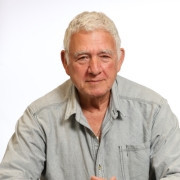פרופ' דני מיכאלסון הוא מנהל מרכז רבין לניורביולוגיה באוניברסיטת תל-אביב. בתחילת דרכו המקצועית זכה בפרס פולברייט הייז מטעם משרד החוץ של ממשלת ארה"ב. במהלך השנים זכה ביותר מ-30 מענקי מחקר מטעם גופים שונים בישראל ובעולם, ביניהם: חברת טבע, האקדמיה הישראלית למדעים, NIH והאיחוד האירופי.
פרופ' דניאל מוריס מיכאלסון

מידע כללי
CV
|
Education: |
|
| 1970-1973 |
Ph.D..; Biophysics, University of California at Berkely |
| 1968-1969 | M.Sc.; Biophysics, Harvard University |
| 1965-1968 | B.Sc.; Physics, Hebrew University |
|
Academic Appointments: |
|
| 2006-present | Director; The Rabin Institute of Neurobiology, Tel Aviv University |
| 1991 | Visiting Professor; Yale University School of Medicine |
| 1988-present | Professor; Department of Neurobiology, Tel Aviv Unviersity |
| 1983-1988 | Associate Professor; Department of Neurobiology, Tel Aviv University |
| 1981-1983 | Visting Professor; Neurobiology, Stanford University |
| 1975-1983 | Lecturer; Tel Aviv University |
|
Honors and Awards: |
|
| 1997-present | Incumbent, The Myriam Lebach Chair in Molecular Biology |
| 1968-1973 | Fulbright-Hays Award sponsored by the United States State Department |
|
Editorial Board: Brain Aging; Current Alzheimer Research; Neurobiology of Lipids; Journal of Alzheimer’s Disease |
|
|
Advisory Board: The Alzheimer Association; Aslan: International Academy of Aging. The New York Academy of Sciences ; The Israeli National Institute of Psychobiology; The Israeli Alzheimer Association |
|
Research Interests
The research in the Michaelson laboratory is directed at unraveling the basic cellular and molecular mechanisms underlying neurodegenration in Alzheimer's disease and at the development of novel therapeutic approaches to counteract them. The research focuses on apolipoprotein E4 (apoE4), the most prevalent genetic risk factor of the disease ,and on it's interaction with other risk factors. Accordingly the following specific projects are being pursued: Developments of in vivo models utilizing apoE4 and apoE3 targeted replacement mice; The mechanism underlying the pathological effects of apoE4; Development of apoE4 directed immune treatment of Alzheimer's disease
The next step of this work is to produce second generation monoclonal Abs which react specifically with native brain apoE4. Since this approach is targeted at the native brain form of apoE4 it is expected to to be much more effective that the previous approach in which the Abs were directed at recombinanat apoE4 which is a non physiological form of this molecule.
Selected Publications
Blumenfeld-Katzir, T., Michaelson, D.M. and Yaniv, A.(2014) ApoE genotype Effect on Brain Plasticity Studied with MRI (submitted)
Boehm-Cagan, A., Michaelson, D.M. (2014) Reversal of apoE4-driven brain pathology and behavioral deficits by bexarotene. J. Neurosci. 34(21): 7293-7301.
Michaelson, D.M. (2014) ApoE4: the most prevalent yet understudied risk factor for Alzheimer’s disease. Alzheimer’s and Dementia, Sept. 2014.
Gilat-Frenkel, M., Bohem-Cagan, A., Liraz, O., Xian, X., Herz, J., Michaelson D.M. (2014) Involvement of the apoER2 and Lrp1 receptors in mediating the pathological effects of apoE4 in vivo. Curr. Alzheimer Res. 11(6): 549-557.
Shiran Salomon-Zimri, Ori Liraz), and Daniel M. Michaelson (2014). Behavioral testing affects the phenotypic expression of apoE3 and apoE4 in targeted replacement mice and reduces the differences between them.In Alzheimer's & Dementia: Diagnosis, Assessment & Disease Monitoring Alzhiemer's and dementia: (in press)
Salomon-Zimri,S., Boehm-Cagan,A., Liraz,O., and. Michaelson, D.M.,(2014). Hippocampal- related cognitive impairments in young apoE4-targeted replacement mice. Neurodegener. Dis.13(2-3); 86-92.
Liraz, O., Boehm, A., Michaelson, D.M. (2013) Aβ, tau and synaptic pathology are induced by apoE4 at a young age. Molecular Neurodegeneration . 2013 May 17;8:16
Zepa, L., Frenkel, M., Belinson ,H., Kayed, R., Masliah, E., and Michaeslon, D.M (2011) ApoE4-driven accumulation of intraneuronal oligomerized Aβ42 following activation of the amyloid cascade in vivo is mediated by a gain of function. Int. J. Alzheimer Disease. Feb (2011) 79170).
Kariv-Inbal, Z., Yacobson, S., Berkez, R., Peter, M., Janaky, T., Lutjohanm D., Broersen, L.M., Hartman,, T., Michaelson, D.M. (2011) The isoform specific pathological effects of apoE4 in vivo are prevented by a fish oil (DHA) diet and modified by cholesterol. J. Alzheimer. Disease. 28(3), 667-683.
Belinson, H., Kariv-Inbal, Z., Kayed, R., Masliah, E., Michaeslon, D.M. (2010) . ApoE4 drives the oligomerization of Abeta in vivo following activation of the amyloid cascade resulting in neurodegeneration . J. Alzheimer Disease 22(3), 959-970.
Belinson, H., and Michaelson, D.M. (2009) Pathological synergism between amyloid-beta and apolipoprotein E4 – the most prevalent yet understudied genetic risk factor for Alzheimer's disease. J. Alzheimers Dis. 17(3), 469-481.
Belinson, H., Lev, D., Masliah, E., and Michaelson D.M .( 2008) Activation of the amyloid cascade in apoE4 tansgenic mice induces lysosomal activation and neurodegeneration resulting in marked cognitive deficits. J. Neuroscie.28(11), 4690-701.
Dolev, I. And Michaelson, D.M. (2004) A nontransgenic mouse model shows inducible amyloid-beta pep deposition and elucidates the role of apolipoprotein E in the amyloid cascade. Proc. Natl. Acad. Sci. U.S.A. 101(38):13909-13914.

